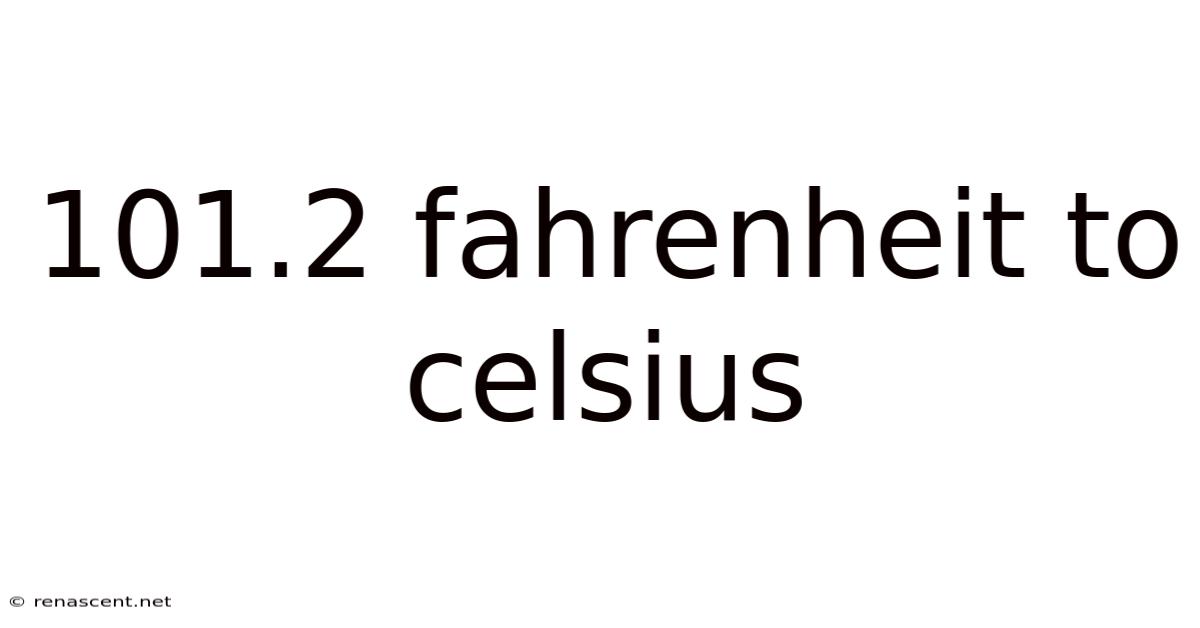101.2 Fahrenheit To Celsius
renascent
Sep 21, 2025 · 4 min read

Table of Contents
Decoding 101.2 Fahrenheit to Celsius: A Comprehensive Guide
Have you ever wondered how to convert temperatures between Fahrenheit and Celsius? Understanding this conversion is crucial in various fields, from cooking and meteorology to medicine and engineering. This comprehensive guide will not only show you how to convert 101.2 Fahrenheit to Celsius but also delve into the underlying principles, provide practical examples, and answer frequently asked questions. We'll explore the history of these temperature scales and offer insightful tips for accurate conversions. This guide aims to leave you confident and knowledgeable about temperature conversions, equipped to tackle any similar conversions in the future.
Understanding Fahrenheit and Celsius
Before diving into the conversion, let's briefly understand the two scales:
-
Fahrenheit (°F): Developed by Daniel Gabriel Fahrenheit in the early 18th century, this scale sets the freezing point of water at 32°F and the boiling point at 212°F, with 180 degrees separating them. It's predominantly used in the United States and a few other countries.
-
Celsius (°C): Also known as the Centigrade scale, it was developed by Anders Celsius in the 18th century. It sets the freezing point of water at 0°C and the boiling point at 100°C, with 100 degrees separating them. It's the most widely used temperature scale globally and the standard in scientific contexts.
Converting 101.2 Fahrenheit to Celsius
The conversion from Fahrenheit to Celsius involves a simple formula:
°C = (°F - 32) × 5/9
Let's apply this formula to convert 101.2°F:
°C = (101.2 - 32) × 5/9
°C = 69.2 × 5/9
°C = 38.44
Therefore, 101.2 Fahrenheit is equal to 38.44 Celsius.
Step-by-Step Conversion Process
To make the conversion process clearer, let's break it down step-by-step:
-
Subtract 32 from the Fahrenheit temperature: 101.2°F - 32°F = 69.2°F
-
Multiply the result by 5: 69.2°F × 5 = 346°F
-
Divide the result by 9: 346°F / 9 = 38.44°C
This step-by-step approach makes the calculation easier to follow, especially for those less familiar with mathematical formulas.
The Science Behind the Conversion
The different values for the freezing and boiling points of water in Fahrenheit and Celsius stem from the different reference points used in their original development. The conversion factor 5/9 reflects the ratio between the size of the degree intervals in the two scales. There are 180 degrees between the freezing and boiling points of water on the Fahrenheit scale and 100 degrees on the Celsius scale. The ratio 180/100 simplifies to 9/5, and hence the reciprocal 5/9 is used in the conversion formula.
Practical Applications of Temperature Conversion
Accurate temperature conversion is crucial in many fields:
-
Medicine: Human body temperature is often measured in Fahrenheit (e.g., 98.6°F), while medical professionals worldwide utilize Celsius for diagnosis and treatment. Converting between these scales is vital for accurate diagnosis and effective communication. A temperature of 101.2°F (38.44°C) suggests a mild fever.
-
Cooking: Many recipes, particularly those originating from the US, might use Fahrenheit. Converting to Celsius is essential for accurate baking and cooking results, ensuring dishes turn out as intended.
-
Meteorology: Weather reports often provide temperatures in both Fahrenheit and Celsius, depending on the target audience. Understanding the conversion ensures you can interpret weather data regardless of the scale used.
-
Engineering: In various engineering disciplines, consistent use of the Celsius scale (or Kelvin) is crucial for precise calculations and ensuring the safety and functionality of engineered systems.
Frequently Asked Questions (FAQ)
Q1: Can I convert Celsius to Fahrenheit?
Yes, the reverse conversion is equally important. The formula is: °F = (°C × 9/5) + 32
Q2: Why are there two different temperature scales?
Historically, different scales evolved independently, leading to the use of both Fahrenheit and Celsius. While the scientific community overwhelmingly favors Celsius (and Kelvin), the Fahrenheit scale remains prevalent in certain regions due to historical reasons and established usage.
Q3: Is there a simpler way to convert temperatures?
While the formula is relatively straightforward, online temperature converters can provide quick and accurate results. However, understanding the underlying principles is crucial for developing a strong foundational understanding of temperature measurement and conversion.
Q4: What is the Kelvin scale?
The Kelvin scale (K) is an absolute temperature scale. It's based on absolute zero, the theoretical point where all molecular motion ceases. 0 K is equivalent to -273.15°C or -459.67°F. The Kelvin scale is extensively used in scientific applications because it simplifies many thermodynamic calculations. The conversion from Celsius to Kelvin is simply: K = °C + 273.15
Conclusion
Converting 101.2 Fahrenheit to Celsius (38.44°C) is a straightforward process once you understand the formula and the underlying principles. This ability to convert temperatures between different scales is a valuable skill in diverse fields. Whether you're a student, a cook, a medical professional, or an engineer, mastering this conversion enhances your understanding of temperature measurement and allows for seamless communication and accurate calculations across various contexts. Remember the importance of accurate conversions, particularly in applications where precision is critical for safety or effectiveness. By understanding both the mathematical process and the underlying scientific principles, you'll be well-equipped to handle any temperature conversion with confidence.
Latest Posts
Latest Posts
-
57 Divided By 2
Sep 21, 2025
-
26 2 Miles Into Kilometers
Sep 21, 2025
-
Converter Kpa To Psi
Sep 21, 2025
-
325 F In Centigrade
Sep 21, 2025
-
3 Percent Of 68
Sep 21, 2025
Related Post
Thank you for visiting our website which covers about 101.2 Fahrenheit To Celsius . We hope the information provided has been useful to you. Feel free to contact us if you have any questions or need further assistance. See you next time and don't miss to bookmark.